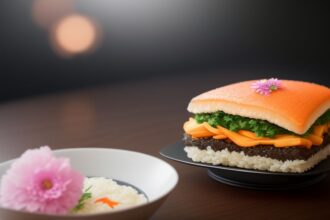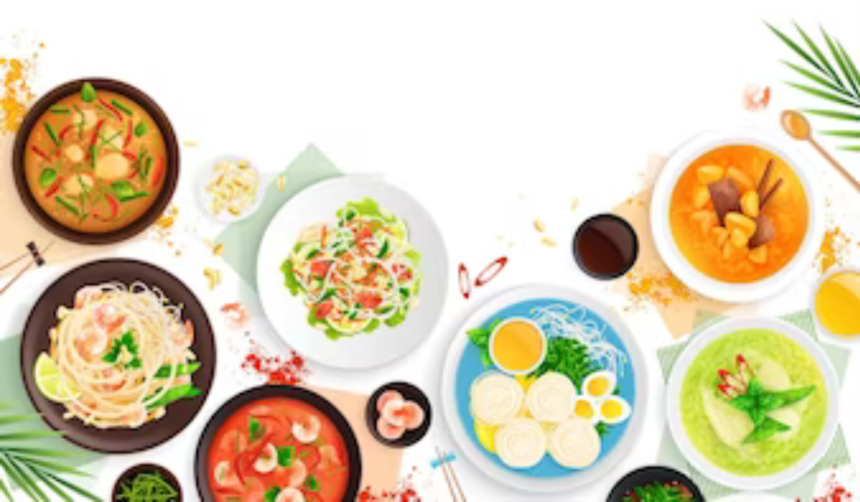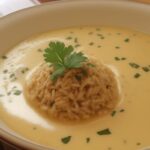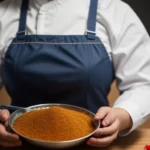In recent years, Thai cuisine has become increasingly popular worldwide for its vibrant flavors, fresh ingredients, and unique blend of influences from various cultures. Known for its balance of sweet, sour, salty, and spicy flavors, Thai cuisine offers a sensory experience like no other. Let’s delve into the world of Thai cuisine: a fusion of flavors and cultures that will tantalize your taste buds.
1. Introduction to Thai Cuisine
Thai cuisine is a reflection of Thailand’s rich history and diverse cultural influences. From royal palaces to street food stalls, Thai dishes are enjoyed by people of all walks of life. The cuisine is characterized by its use of fresh herbs and spices, like lemongrass, galangal, kaffir lime leaves, and chili peppers, which give each dish a unique and complex flavor profile.
2. Geography and Ingredients
Thailand’s geographical location plays a significant role in its culinary traditions. With access to abundant seafood, tropical fruits, and aromatic herbs, Thai cuisine is known for its use of fresh and locally sourced ingredients. Staples like jasmine rice, coconut milk, and fish sauce are commonly used in many Thai dishes.
3. Influences of Thai Cuisine
Thai cuisine has been influenced by various cultures over the centuries, including Chinese, Indian, Malay, and European. These influences have shaped the flavor profiles of traditional Thai dishes, creating a fusion of flavors that is both complex and harmonious.
4. Flavors of Thai Cuisine
One of the defining characteristics of Thai cuisine is its balance of five essential flavors: sweet, sour, salty, bitter, and spicy. Thai dishes often incorporate a combination of these flavors to create a harmonious and well-rounded taste experience.
5. Street Food Culture
In Thailand, street food is a way of life. From bustling markets to roadside vendors, there is no shortage of delicious and affordable street food options in Thailand. Some popular street foods include pad thai, mango sticky rice, and grilled satay skewers.
6. Regional Variations
Thailand is divided into four main culinary regions: Northern, Northeastern (Isan), Central, and Southern. Each region has its own unique cooking styles, ingredients, and flavor profiles. For example, Northern Thai cuisine is known for its use of earthy herbs and spices, while Southern Thai cuisine is characterized by its bold and fiery flavors.
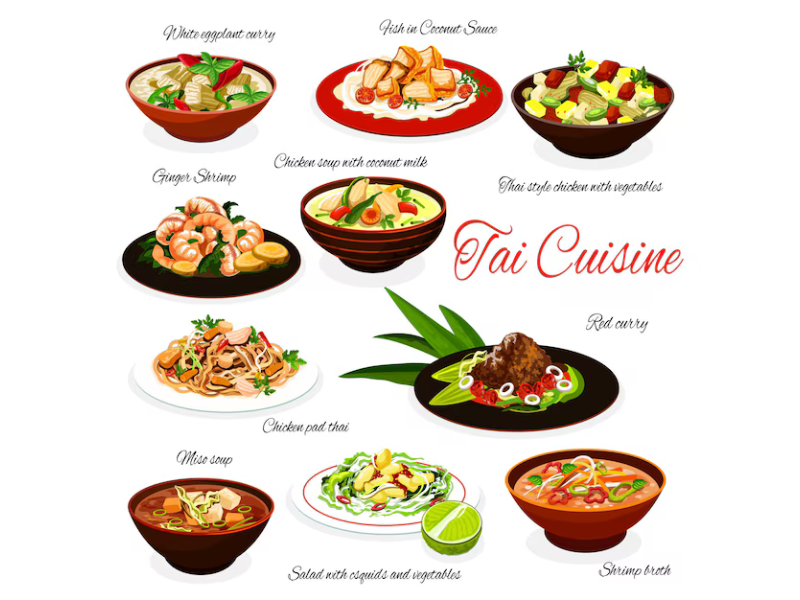
7. Popular Thai Dishes
Thai cuisine boasts a wide array of popular dishes that are enjoyed both in Thailand and around the world. Some classic Thai dishes include green curry, tom yum soup, pad see ew, som tum (papaya salad), and massaman curry. Each dish showcases the unique flavors and cooking techniques that make Thai cuisine so special.
8. Thai Street Food Staples
Street food is an integral part of Thai culture, offering a wide variety of affordable and delicious options for locals and tourists alike. Some popular street food staples include spring rolls, fried chicken, fish cakes, and coconut pancakes. These dishes are often served with a side of fresh herbs and spicy dipping sauces.
9. Dining Etiquette
In Thai culture, dining is a communal experience that is meant to be shared with friends and family. It is common to order multiple dishes and share them among the table. Traditional Thai meals consist of a variety of dishes, including soups, curries, stir-fries, and salads.
10. Thai Ingredients and Cooking Techniques
Thai cuisine is known for its use of fresh ingredients and meticulous cooking techniques. Ingredients like coconut milk, fish sauce, and shrimp paste are commonly used in Thai dishes to enhance flavor and texture. Thai chefs often use a variety of cooking methods, including stir-frying, steaming, and grilling, to create flavorful and aromatic dishes.
11. Vegetarian and Vegan Options
Thailand is known for its abundance of fresh fruits and vegetables, making it a paradise for vegetarians and vegans. Many Thai dishes can be easily adapted to accommodate a plant-based diet, with options like vegetarian pad thai, green curry with tofu, and coconut milk-based desserts.
12. Health Benefits of Thai Cuisine
Thai cuisine is not only delicious but also packed with health benefits. Many Thai dishes are rich in antioxidants, vitamins, and minerals, thanks to the use of fresh herbs and vegetables. Ingredients like lemongrass, turmeric, and ginger are known for their anti-inflammatory and immune-boosting properties.
13. Thai Desserts
No Thai meal is complete without a sweet treat to finish. Thai desserts are known for their use of tropical fruits, coconut milk, and sticky rice. Some popular Thai desserts include mango sticky rice, coconut ice cream, and crispy banana fritters.
14. Thai Beverages
In addition to its delicious cuisine, Thailand is also known for its refreshing beverages. Thai iced tea, made with sweetened condensed milk and black tea, is a popular choice for cooling down on hot days. Other popular Thai beverages include coconut water, fresh fruit smoothies, and herbal teas.
15. Conclusion
Thai cuisine is a colorful tapestry of flavors, textures, and aromas that reflect the diverse culture and history of Thailand. From street food stalls to fine dining restaurants, Thai cuisine offers a culinary adventure like no other. Whether you’re a fan of spicy curries, tangy salads, or sweet desserts, there’s something in Thai cuisine for everyone to enjoy. So, the next time you’re craving a flavorful and satisfying meal, consider exploring the world of Thai cuisine and experience the fusion of flavors and cultures that make it so special.
FAQs about “Thai Cuisine: A Fusion of Flavors and Cultures”
- What makes “Thai Cuisine: A Fusion of Flavors and Cultures” a standout exploration of Thai food? “Thai Cuisine” offers a unique perspective on Thai food, highlighting its fusion of flavors and influences from various cultures. It provides an in-depth look at the diverse ingredients, cooking techniques, and regional specialties that define Thai cuisine.
- Which cultures contribute to the fusion of flavors in Thai cuisine? Thai cuisine is influenced by various cultures, including Chinese, Indian, Malay, and European. “Thai Cuisine” explores how these diverse culinary traditions have shaped Thai cooking, resulting in a vibrant fusion of flavors and ingredients.
- Are specific Thai dishes featured in this culinary exploration? Yes, “Thai Cuisine” features a wide range of Thai dishes, from classic favorites like pad Thai and green curry to lesser-known regional specialties. Each dish is accompanied by background information, cultural insights, and tips for preparing it authentically.
- How does this book delve into the cultural heritage of Thai cuisine? This book delves into the cultural heritage of Thai cuisine by exploring its origins, influences, and significance in Thai society. Readers will learn about the historical and cultural context of Thai dishes, as well as the traditions and customs associated with Thai culinary customs.
- Can readers expect to gain insights into the regional variations of Thai cuisine in this book? Absolutely! “Thai Cuisine” celebrates the regional diversity of Thai cuisine by featuring dishes from different parts of Thailand. From the fiery curries of the South to the aromatic soups of the North, readers will discover the distinct flavors and culinary traditions of each region.
Advantages:
- Inclusive language: The title “Thai Cuisine: A Fusion of Flavors and Cultures” suggests that Thai cuisine is a blend of diverse influences, appealing to readers interested in exploring culinary diversity.
- Cultural immersion: The title implies a deep dive into Thai culinary traditions, offering readers insights into the history, ingredients, and techniques that contribute to the richness of Thai cuisine.
- Gastronomic exploration: Readers can anticipate discovering a variety of Thai dishes that showcase the fusion of flavors and influences from different cultures, providing them with a comprehensive overview of Thai culinary landscape.
- Practicality: By focusing on Thai cuisine, the title appeals to readers interested in exploring authentic and delicious Thai dishes, providing them with recipes, tips, and techniques.
- Inspiration for travel: The title may inspire readers to visit Thailand to experience its culinary delights firsthand, fostering a deeper connection to Thai cuisine and culture.
Disadvantages:
- Potential oversimplification: While Thai cuisine does incorporate elements from various cultures, focusing solely on fusion may oversimplify the richness and complexity of Thai culinary traditions, overlooking indigenous dishes and cultural nuances.
- Lack of specificity: The title does not specify which dishes will be explored or which cultural influences will be highlighted, leaving readers uncertain about the scope of the content.
- Cultural appropriation: Without proper context and understanding, celebrating Thai cuisine as a fusion of flavors and cultures could risk appropriating cultural elements without acknowledging their significance or respecting their origins.
- Inaccurate representation: While some Thai dishes may indeed be fusion creations, portraying Thai cuisine primarily as a fusion may not accurately reflect the depth and authenticity of traditional Thai dishes.
- Dietary restrictions: Thai cuisine often includes ingredients like fish sauce, shrimp paste, and peanuts, which may not be suitable for individuals with dietary restrictions or preferences, potentially alienating some readers.



